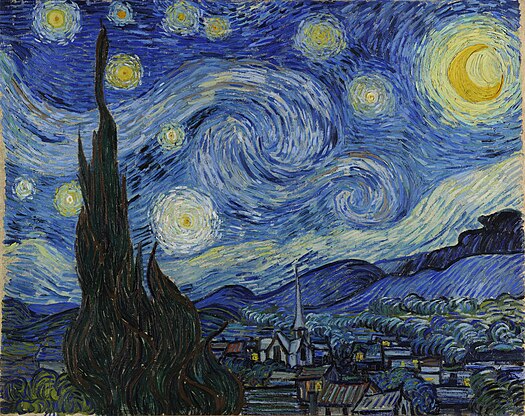

Vincent van Gogh used oil paints on a canvas for The Starry Night. He favored high-quality pigments that were bright and expressive in keeping with his bold, dynamic style. Frequently, he purchased his paints in tubes so that they were more transportable and easier to manipulate, with thick applications of paint, referred to as impasto. It gave the painting a three-dimensional look with thick texture, mainly in the sky and in the star portion.
For his brushes, he used a range of sizes, always in flat and round, in order to create broad strokes and minute details. The Starry Night was painted on a pre-stretched, pre-primed canvas prepared with a white ground layer, common at that time, in order to enhance the brilliance of his colors.
He also used a wooden palette for mixing colors, often playing with mixtures to arrive at the brilliant blues, yellows, and greens that dominate the painting. To achieve the effects he wanted, van Gogh would sometimes use a palette knife in spreading paint and building texture. The mastery of such materials and techniques resulted in this visually stunning and emotionally profound masterpiece that has continued to enthrall viewers.
Vincent van Gogh painted The Starry Night to express his inner emotions, spiritual reflections, and fascination with the natural world. Painted in June 1889 while he was an inmate at the asylum of Saint-Paul-de-Mausole in Saint-Rémy-de-Provence, the painting reflects both his turbulent mental state and his yearning for tranquility and meaning. Van Gogh had voluntarily admitted himself to the asylum after a period of mental health struggles, and the view from his room's barred window became a source of inspiration. Starry Night is based loosely on this view, but van Gogh infused it with imagination-exaggerating the swirling sky, glowing stars, and towering cypress-to convey a sense of wonder and emotional intensity.
For van Gogh, this painting was not simply a literal representation of night, but a deeply personal journey into the cosmos, connected with human existence. He wrote to his brother Theo that the night sky "is more alive and colored than the day," signifying how much he was captivated by the nocturnal world. It may also speak to his spiritual longing, as the cypress tree conventionally represents eternity and the church spire denotes a search for divine connection. While van Gogh looked to nature for solace, his mental turmoil gave added depth to the painting, making The Starry Night an intensely emotive and symbolic work.